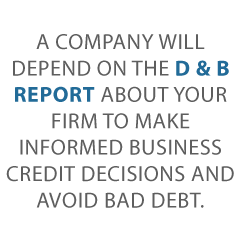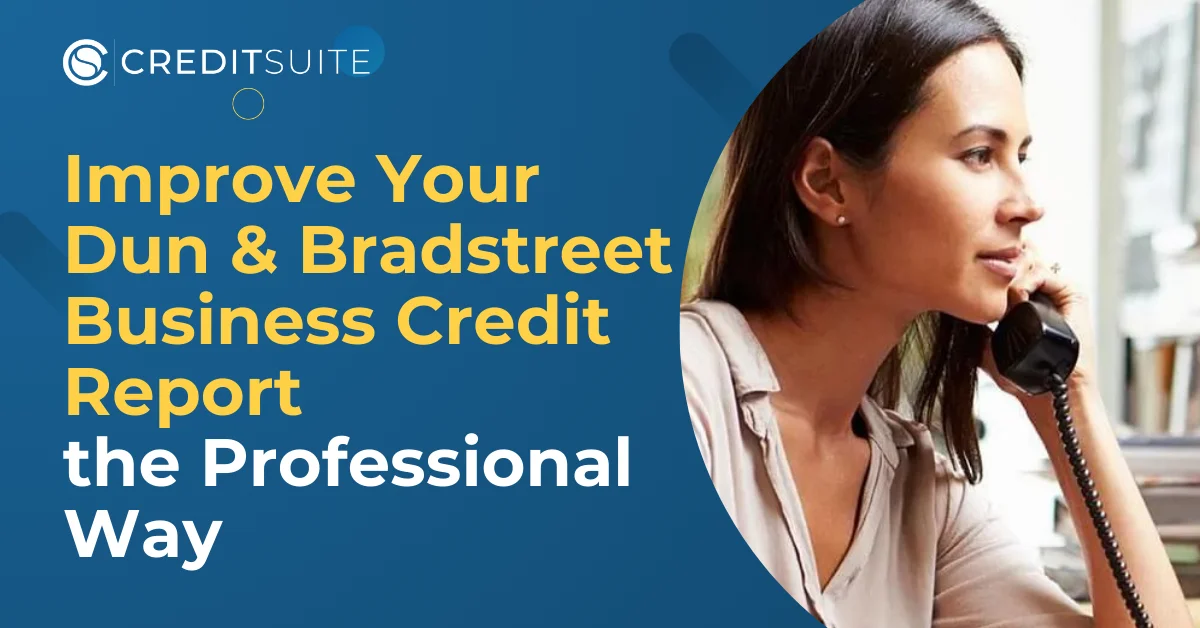Improve Your Dun & Bradstreet Business Credit Report
 Your D & B Report (also known as your (Dun & Bradstreet Report) is a database-generated report. The business services giant generates such a report. So this is to help its clients in making decisions about new credit applications. Improve your Dun & Bradstreet business credit report and get more amazing funding opportunities!
Your D & B Report (also known as your (Dun & Bradstreet Report) is a database-generated report. The business services giant generates such a report. So this is to help its clients in making decisions about new credit applications. Improve your Dun & Bradstreet business credit report and get more amazing funding opportunities!
It is one of the first things a company will check when determining whether to do so business with you at all. Dun & Bradstreet offers these reports to their customers. They are meant to help determine if a potential supplier, vendor, or business partner, is a good credit risk. A company will depend on the D & B report about your firm to make informed business credit decisions and avoid bad debt.
Why Use a D&B Report?
The main reason for a client using a Dun and Bradstreet report is to engage in credit risk monitoring of vendors, suppliers, and business partners. This helps companies make smart business credit decisions and steer clear of bad debt. It’s always a good idea to monitor credit.
Dun & Bradstreet takes many factors into account in producing such a report. These include a predictor of payment delinquency. And they include under how much financial stress a company is under versus comparable businesses. Plus there’s an assessment of supplier risk; credit limit recommendation; D&B rating; and PAYDEX score. Let’s consider all of these factors in turn in Dun and Bradstreet reports.
Improve Your Dun & Bradstreet Business Credit Report: 1. Delinquency Predictor
To estimate out how likely your company is to be late in paying your financial obligations, Dun & Bradstreet takes historical information to try to predict future outcomes. D & B identifies the risks inherent in a future decision, by comparing historical information to a future event.
This is done through the use of predictive models. It entails identifying the risks inherent in a future decision. It does this by examining the relationship between historical information and the future event.
What’s Predictive Modeling?
This represents an objective and statistically derived counterpart to subjective and intuitive analyses. Such scoring enables a business to rank and order accounts. So they base their scores on the probability of an event occurring, such as delinquent payments.
But note that Predictive Scoring only represents a statistical probability of account delinquency or the like, and not a guarantee.
You can improve this measure by paying your company’s bills on time. It is the easiest way to go about establishing business credit.
Improve Your Dun & Bradstreet Business Credit Report: 1a. Supplier Evaluation Risk Rating
The Supplier Evaluation Risk Rating (also called a SER Rating) calculates how likely it is that a company will get legal relief from its creditors or end its operations without paying creditors in full over next twelve months. This rating comes from D&B’s Financial Stress Score.
The Financial Stress Score percentile serves as the basis for the SER Rating.
Details
Once a company’s Financial Stress Score percentile is determined, a second set of rules apply to figure the SER Rating. The SER Rating provides a probability of worldwide supplier failure. Local nations’ failure ratings are shown via a Class of 1 – 9.
A 1 represents businesses with the lowest probability of supplier failure. A 9 represents companies with the highest probability of supplier failure.
Improve Your Dun & Bradstreet Business Credit Report: 2. Financial Stress Score Percentile
A Financial Stress Score Percentile is shown as a 1-100 ranking where a 1 percentile has the highest probability of failure and a 100 percentile has the lowest probability of failure.
If D & B identifies your company as under financial stress that means several things. You may have ceased operations following assignment of bankruptcy. Or you may have voluntarily withdrawn from business operation with unsettled obligations.
Another possibility is you have closed up shop with a loss to creditors. Or your company is in receivership or reorganization. Another possibility is that you have made some sort of a plan for the benefit of your creditors.
It may sound easier said than done, but probably the best way to improve this particular aspect is to avoid receivership. Good financial responsibility helps the most here.
Improve Your Dun & Bradstreet Business Credit Report: 2a. Financial Stress Percentile
The Financial Stress Percentile compares the company in question to other businesses in the same location, industry, number of employees, or amount of years in the business. Financial Stress Score Norms show an average score and percentile. So this is for all firms with similar demographic characteristics.
These Norms can be used to measure where this particular business stands in relation to the norm for its peer group.
More Improvements
How do you keep yours in line? This is where competitor research can come in handy. Don’t have access to experts? No worries – a lot of this data is publicly available online.
At the very least, you can certainly Google your competition and read their websites. Get a feel for how large they are and how long they have been in business.
Of course you can’t make your company older than it truly is. But at the very least, you can get an idea of what you’re up against.
Improve Your Dun & Bradstreet Business Credit Report: 3. Financial Stress Risk Class
This is a division of the scored universe into five distinct groups, ranging from 1 to 5. A 1 represents businesses which have the lowest probability of failure. While a 5 represents firms which have the highest probability of failure.
This Class makes it so a customer can quickly segment their new and existing accounts into various risk segments. This is to identify suitable marketing or credit policies.
D & B scores your company with respect to businesses least likely or most likely to fail. Therefore a D & B customer can quickly separate their new and existing accounts by risk and then decide how to proceed.
If your business is shown as being Discontinued at This Location; Higher Risk; or Open Bankruptcy, you will automatically get a 0 score.
To improve this score, make sure you update your location if you move. And make an effort to not declare bankruptcy. If your business is high risk, you cannot do anything about that, though.
Improve Your Dun & Bradstreet Business Credit Report: 3a. Financial Stress Score
Dun & Bradstreet generates Financial Stress Scores to predict the possibility of business failure over the upcoming twelve months.
D&B defines business failure in several ways. One is as a company which gets legal relief from its creditors. Another is a business which ceases its business operations without paying all of its creditors in full.
Yet another is a company which voluntarily withdraws from its business operations thereby leaving unpaid obligations.
Another way is a company which enters into receivership or reorganization. Or it can be a business which makes some form of arrangement for the benefit of its creditors. And all of this has a basis in the information found within D&B’s commercial database.
The score ranges from 1,001 to 1,875. A score of 1,001 stands for the highest probability. While a figure of 1,875 exemplifies the lowest probability of business failure.
If your firm has a lot of lawsuits and liens against it, those will negatively impact your financial stress score.
Improve Your Dun & Bradstreet Business Credit Report: 4. Composite Credit Appraisal
This number, between 1 through 4, makes up the second half of your firm’s rating. It shows Dun & Bradstreet’s overall rating of your business’s creditworthiness. Dun & Bradstreet’s uses its analysis of company payments and financial information. And it also uses its analysis of public records, business age and other important factors. When they are available, D&B interprets these to generate a Composite Credit Appraisal.
If your company does not supply current financial information, you can’t get a Composite Credit Appraisal rating above a 2. In general, when Dun & Bradstreet does not have all of the information they need, they will show that in their reports.
But missing information does not necessarily mean your firm is a poor credit risk.
These rating classifications are assigned to company files which do not include a current financial statement. Employee Range (ER) Ratings apply to certain lines of business not lending themselves to classification under the D&B Rating system.
These kinds of companies get an Employee Range symbol based on the number of employees and nothing more.
Improve this score by providing as much pertinent information as possible.
Improve Your Dun & Bradstreet Business Credit Report: 4a. Credit Limit Recommendation
A D&B Credit Limit Recommendation includes two recommended dollar guidelines:
1. A conservative limitation, suggesting a dollar benchmark if a company’s policy is to extend less credit to minimize risk and
2. An aggressive restriction, proposing a dollar benchmark if a firm’s policy is to extend more credit with potentially more risk.
These dollar guideline amounts have a basis in a historical analysis of the credit demand of customers in the U.S. payments database. And these are customers with a similar profile to the firm being evaluated, with respect to employee size and industry.
The guidelines do not address whether a particular company can pay that amount. And they don’t address if a particular customer’s total credit limit was achieved.
Each set of limits comes with an analysis of the risk category a business falls into, or D&B’s assessment of how likely they are to continue to pay their obligations within the agreed-upon terms and how likely they are to undergo financial stress in the next twelve months.
PAYDEX
A PAYDEX Score is Dun & Bradstreet’s proprietary dollar-weighted mathematical rating of how your company has paid the bills over the past year. D & B bases this score on trade experiences from various vendors’ reports.
In addition, the D&B PAYDEX Score ranges from 1 to 100. So higher scores indicate a better payment performance.
Improve this score by maintaining good relationships with your vendors. And make sure they report to D & B. It helps a lot to get vendor payments onto your Dun and Bradstreet credit report.
To guarantee as accurate a report as possible, it quite literally pays to provide D & B with your company’s current financial statements.
Improve Your Dun & Bradstreet Business Credit Report: 5a. D&B Rating
The idea behind a D&B Rating is to help firms quickly gauge a business’s size and composite credit appraisal. The rating has its basis in information in a company’s interim or fiscal balance sheet. Plus it’s a look at an overall evaluation of the firm’s creditworthiness.
5A to HH Rating Classifications show company size based on worth or equity as computed by Dun & Bradstreet. So the figure is important because a firm’s size can be an effective indicator of credit capacity.
Dun & Bradstreet assigns such D&B ratings to businesses which have given a current financial statement.
A Word About D&B Data
Finally, any report is only as good as the data it comes from. Dun & Bradstreet’s database contains info on hundreds of millions of businesses spanning the globe. So it also includes companies which are out of business. But they kept for historical reasons.
D&B continuously gathers data and works to improve its analyses. So this is to assure the greatest degree of accuracy possible.
Find out why so many companies are using our proven methods to build business credit. And you, too, can improve your Dun & Bradstreet business credit report.

